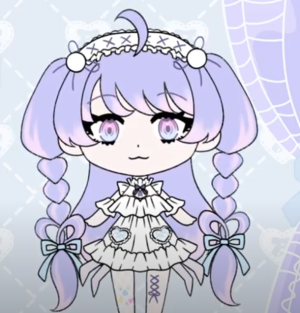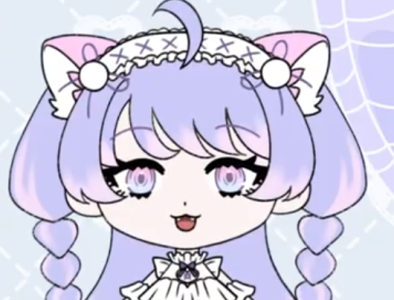He did got a bit of pushback from one person, but don't expect anything harder than that.I have to agree. Hell, on the Farms I saw Lester Jones posted a colossal dox of what I think was Lia and the whole thing seemed like an absolute dick move. Worse that no one really called the guy out on it. It's one thing to dig that deep on someone like the Zoosadists if you're trying to track them down, but doing that to a girl who just wants to entertain people with a separate identity/character just makes you a psychopath as far as I'm concerned.
"I watched a video, people can fit a laccoon in their butthole... I don't get it, is it a bad thing? Is it a bad thing? I'll stop talking lol"Meloco Kyoran
You are using an out of date browser. It may not display this or other websites correctly.
You should upgrade or use an alternative browser.
You should upgrade or use an alternative browser.
General Vtuber Discussion (V1)
- Thread starter The Proctor
- Start date
- Status
- Not open for further replies.
Tenma Follow up from previous post:
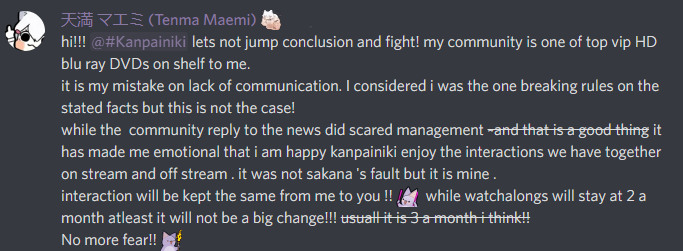
previous Post:

previous Post:
Kanpainki are having a meltdown with recent announcement on the PCD. This comes from Tenma about doing stuff less on discord, but unclear if fishman also wants her to interact with people less on the discord too.
View attachment 5039
Edit:
Lol did Tenma just use her fanbase to get fishman to turn things around?
View attachment 5040
View attachment 5041
thhrang
Punished Autism Extraordinaire
Early Adopter
Ward Security
♥Realticule's Husbando♥
Joined:
Sep 13, 2022
I have to agree. Hell, on the Farms I saw Lester Jones posted a colossal dox of what I think was Lia and the whole thing seemed like an absolute dick move. Worse that no one really called the guy out on it. It's one thing to dig that deep on someone like the Zoosadists if you're trying to track them down, but doing that to a girl who just wants to entertain people with a separate identity/character just makes you a psychopath as far as I'm concerned.
I mean, I did try & say something when he did this shit to Pippa a few months back, but nothing came of it.He did got a bit of pushback from one person, but don't expect anything harder than that.
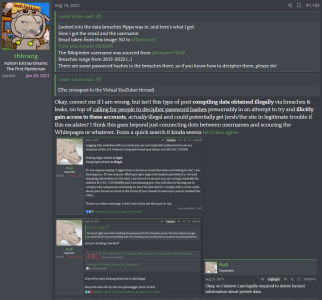

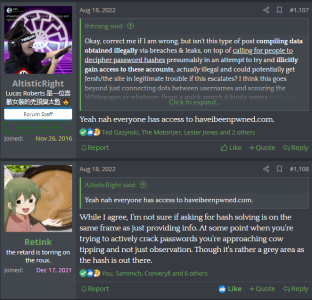
Tardwrangling the CEO.Kanpainki are having a meltdown with recent announcement on the PCD. This comes from Tenma about doing stuff less on discord, but unclear if fishman also wants her to interact with people less on the discord too.
View attachment 5039
Edit:
Lol did Tenma just use her fanbase to get fishman to turn things around?
View attachment 5040
View attachment 5041
Hm. Can we identify decent corps by how little the talents tardwrangle their boss?
Hahah Kaira just scored a C in Blue Danube and proceeded to call the game a cunt.


I have awakened...Was reading a bit in the reddit thread where this image was also shared and found this:
View attachment 5014
Numbers.
I'm no accountant and dont plan on becoming one, but I someone here thinks its interesting to look at, I'm posting it anyways.
Not sure if there is any interesting take-away from these numbers, but if there is, tell me.
So first here's a term to help make this easier to understand and show what I'm looking at.
"YoY" stands for "Year over Year" it is a percentage change from one year to the next, it is intended to be used to observe radical changes in operating income line items so you can ask why these things happened. These are percentages in decimal format, so 120.3 is 120.3% so we're not confused.
It is worth noting that this is an income statement, and not a balance sheet, so we can't determine much in terms of assets or liabilities from this data. This is used to determine how much money was made/lost and how much of these values comes from what sectors (merchandise, administrative/"general business" expenses, commissioning, etc) and trying to use these numbers to ask what we're doing right and wrong. This is the type of end of year data you look at when you ask what you can cut back or improve on to improve overall profitability.
The first thing I'm getting from all of this is something is missing, or at least not very obvious to me. Their is no outright stated SC or talent generated revenue here, or at least it isn't obvious where it is and how much of it is from that source, the top section with all the sales and expenses appears to me primarily focused on merchandise. How do I know this? Look at the revenue and cost items at the top.
"Amount of Sales" This speaks for itself
"Commodity Inventory at beginning of the period." This is starting inventory, aka the amount of at-cost (most likely) merchandise Cover has in a warehouse somewhere.
"Purchases of Products, etc for current period." This is new inventory generated to meet demands for the year.
"Inventory of merchandise at end of the period" This is obviously the ending inventory that you have remaining, the reason why it is a negative number is so you know how much you have to remove from the "cost of sales" number to ensure you aren't counting inventory you haven't even sold yet.
These are all expense accounts focused on the merchandise, not the talents.
Now you could put the salary expense for the talents somewhere in the SEA section right below gross profit, which if it is there I presume it is under the "Misc wages/staff salary" if it is there as executive compensation is at the top. This is usually used for mostly small and irrelevant values that you can't categorize in the usual line items for one reason or another, it is like a footnote account which is strange when talking about the most direct of your talent's expenses.
I presume Cover doesn't think the talent's salary matters enough to make it a more direct and in your face line item, or it is just purposefully vague and they have some internal analysis for this stuff that isn't visible in this (what I presume) public investor focused statement. Most investors likely don't give a shit about this detail so Cover might have just not bothered trying to calculate it very well for investor purposes. It is a waste of time for the accounting department and the auditors to ensure these numbers are correct as they might just be too small in the grand scheme of things.
For the record, "Salary allowance" is not actually a salary per say, it is an amount of money specifically stored to meet non-direct monetary benefits to an employee's salary. This could be stuff like medical stuff, internal discounts, or recompensation for things like gas or whatever that aren't technically part of the base salary you get, so if you get 50k salary and you get your gas covered your part in this pie is 50k salary expense + XXX salary allowance of whatever your gas was. So this has little to do with the talents probably.
Now the best assumption I can make is that "Ordinary income" is the SC based revenue. Because this revenue, unlike merchandise revenue has no direct cost factor to it like merchandise and it is obviously common enough to be considered "Ordinary".
What do I mean by no direct cost factor? If you sell the Totally Coming Soon Magni Dezmond Fursuit when Magni eventually becomes the first official Holopro VFurry, you can track the revenue to a bunch of cost items like materials, labor, and your dignity and then determine how much profit you make from each sale.
It is harder to do that with SCs because it has no direct cost factor that is consistent, Magni could buy every single Sims 4 DLC and get less SC revenue that stream then he did when he started playing Sims 4, while Vesper can talk about his adventures in Magni's fur dungeon and the Target shrine in his closet for free and get a huge surge of SCs compared to his other streams.
So unfortunately it is hard for me, as an outsider to this industry from a business perspective, to confidently say what this says in regards to the talents.
The biggest takeaway I'd say is that Cover is becoming less efficient likely due to their sudden surge in 2020 making them able to achieve more with less the first two periods, while needing to maintain that momentum by spending more yet the momentum is clearly dying so they don't generate the same kind of returns for their costs incurred. March 2022's statement shows a (very small, literally .4% difference) negative difference in net income despite the 100%+ improve in revenues up top as they spent a higher percentage in generating new merchandise. Commissions paid is also through the roof as it is over 100 times bigger going from the 2021 period to the 2022 period, which I presume is from them trying to make new costumes, 3D models, assets, and whatever else for their growing portfolio of talents.
"YoY" stands for "Year over Year" it is a percentage change from one year to the next, it is intended to be used to observe radical changes in operating income line items so you can ask why these things happened. These are percentages in decimal format, so 120.3 is 120.3% so we're not confused.
It is worth noting that this is an income statement, and not a balance sheet, so we can't determine much in terms of assets or liabilities from this data. This is used to determine how much money was made/lost and how much of these values comes from what sectors (merchandise, administrative/"general business" expenses, commissioning, etc) and trying to use these numbers to ask what we're doing right and wrong. This is the type of end of year data you look at when you ask what you can cut back or improve on to improve overall profitability.
The first thing I'm getting from all of this is something is missing, or at least not very obvious to me. Their is no outright stated SC or talent generated revenue here, or at least it isn't obvious where it is and how much of it is from that source, the top section with all the sales and expenses appears to me primarily focused on merchandise. How do I know this? Look at the revenue and cost items at the top.
"Amount of Sales" This speaks for itself
"Commodity Inventory at beginning of the period." This is starting inventory, aka the amount of at-cost (most likely) merchandise Cover has in a warehouse somewhere.
"Purchases of Products, etc for current period." This is new inventory generated to meet demands for the year.
"Inventory of merchandise at end of the period" This is obviously the ending inventory that you have remaining, the reason why it is a negative number is so you know how much you have to remove from the "cost of sales" number to ensure you aren't counting inventory you haven't even sold yet.
These are all expense accounts focused on the merchandise, not the talents.
Now you could put the salary expense for the talents somewhere in the SEA section right below gross profit, which if it is there I presume it is under the "Misc wages/staff salary" if it is there as executive compensation is at the top. This is usually used for mostly small and irrelevant values that you can't categorize in the usual line items for one reason or another, it is like a footnote account which is strange when talking about the most direct of your talent's expenses.
I presume Cover doesn't think the talent's salary matters enough to make it a more direct and in your face line item, or it is just purposefully vague and they have some internal analysis for this stuff that isn't visible in this (what I presume) public investor focused statement. Most investors likely don't give a shit about this detail so Cover might have just not bothered trying to calculate it very well for investor purposes. It is a waste of time for the accounting department and the auditors to ensure these numbers are correct as they might just be too small in the grand scheme of things.
For the record, "Salary allowance" is not actually a salary per say, it is an amount of money specifically stored to meet non-direct monetary benefits to an employee's salary. This could be stuff like medical stuff, internal discounts, or recompensation for things like gas or whatever that aren't technically part of the base salary you get, so if you get 50k salary and you get your gas covered your part in this pie is 50k salary expense + XXX salary allowance of whatever your gas was. So this has little to do with the talents probably.
Now the best assumption I can make is that "Ordinary income" is the SC based revenue. Because this revenue, unlike merchandise revenue has no direct cost factor to it like merchandise and it is obviously common enough to be considered "Ordinary".
What do I mean by no direct cost factor? If you sell the Totally Coming Soon Magni Dezmond Fursuit when Magni eventually becomes the first official Holopro VFurry, you can track the revenue to a bunch of cost items like materials, labor, and your dignity and then determine how much profit you make from each sale.
It is harder to do that with SCs because it has no direct cost factor that is consistent, Magni could buy every single Sims 4 DLC and get less SC revenue that stream then he did when he started playing Sims 4, while Vesper can talk about his adventures in Magni's fur dungeon and the Target shrine in his closet for free and get a huge surge of SCs compared to his other streams.
So unfortunately it is hard for me, as an outsider to this industry from a business perspective, to confidently say what this says in regards to the talents.
The biggest takeaway I'd say is that Cover is becoming less efficient likely due to their sudden surge in 2020 making them able to achieve more with less the first two periods, while needing to maintain that momentum by spending more yet the momentum is clearly dying so they don't generate the same kind of returns for their costs incurred. March 2022's statement shows a (very small, literally .4% difference) negative difference in net income despite the 100%+ improve in revenues up top as they spent a higher percentage in generating new merchandise. Commissions paid is also through the roof as it is over 100 times bigger going from the 2021 period to the 2022 period, which I presume is from them trying to make new costumes, 3D models, assets, and whatever else for their growing portfolio of talents.
tl;dr:
It is effectively impossible to use this data alone to determine much about the talents themselves, especially specific ones, as most the line items are talking about merchandise and boring business shit. Salaries, if they exist as I know that's become a debate on and off here, are in some small account that is barely talked about. This is likely because investors don't give a shit about this as much as we might care about it.
Cover is clearly spending a lot more on all the talents while not getting the same amount of return on investment back as despite their growth they actually have very slightly worse net-income overall going from 2021 period to the 2022 period (Remember these periods end in March, so a ton of year is left). This is likely due to needing to support more of them but not all of them give the same kind of returns for obvious reasons. 2021 period was also when Myth took the world by storm, so the huge differences has to also be considered with the events that actually happened.
I will also note that it wasn't until the 2022 period that Research and Development expenses show up, I can't quite guess what this could be related towards. Perhaps it has something to do with the 3D concerts or something like that, I can't say for sure as I'm not fully aware of the timeline of what Cover has made internally (instead of just buying it from someone else) that could correlate to this. If anyone wants to guess, remember this is for the time period of April 2021 through the end of March 2022.
I hope his has been informative and that I didn't miss anything, their is a lot to comb over with all these line items across three periods. I'm going to now become like Dingo Aniki now after typing all this autism for the last hour.
And nowHahah Kaira just scored a C in Blue Danube and proceeded to call the game a cunt.

Kiwawa is becoming American
I mean, I did try & say something when he did this shit to Pippa a few months back, but nothing came of it.
View attachment 5042View attachment 5043View attachment 5046




Scarle is doing a Tumblr Sexyman tierlist in a few hours. Watch Dez be on the list.
I should start playing the lottery since I'm a prophet now.View attachment 5009
Oh no, Vesper has lost Scarle perms lmao
I need to start watching Lisa, so far I've only ever seen clips of her with Pippa and a bit of singing
Also: I love these dumb ass bitches.
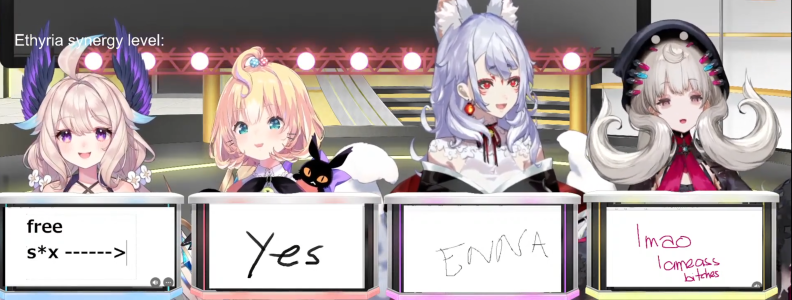
Huge jump in revenue and net income from 2020 to 2021 with that net income being sustained in 2022. At the same time, operating expenses are up which can likely be attributed to expansion and more hiring in the administrative staff as reflected by the increase in administrative expenses (salaries, supplies, allowance, training, etc).Numbers.
I'm no accountant and dont plan on becoming one, but I someone here thinks its interesting to look at, I'm posting it anyways.
Not sure if there is any interesting take-away from these numbers, but if there is, tell me.
Nothing much else to pull from it unless there are other docs out there outlining a breakdown of the revenue.
View attachment 5049
New model for Ami! Made by herself.
Also one year stream for her rn
View attachment 5050
Not a fan of the squished face. I prefer the rounder face in her normal model more. Could also be the eyelash thickness, but something in the face area doesn't quite work for me.
But props to her for actually making it by herself.
Realticule
I do it for the meats!
Early Adopter
I CAN STILL FIX HER
✡︎ God's Chosen Schizo ✡︎
Joined:
Sep 11, 2022
I've said it a few times but I'm not really a fan of doxing though I understand it has its benefits as for example knowing Chris's location allowed to get footage of his arrest and knowing Nikacado Avocados allowed people to deduce that a murder scream was captured in the background of one of his videos using his location and checking for news articles that confirmed there was a stabbing of a woman in the same building.It's one thing to dig that deep on someone like the Zoosadists if you're trying to track them down, but doing that to a girl who just wants to entertain people with a separate identity/character just makes you a psychopath as far as I'm concerned.
That being said, I do think it's not a great idea to dox vtuber girls as unlike Nikacado their crazy fans are a different kind of crazy. Well that and I wouldn't really call any of them lolcows because even at their worst they're much more self aware than someone like DSP.
Pippa, Tenma and Airi are playing the Backrooms with Pwuppygf (Emi).
Also live on Emi's Twitch channel
This stream is already fucking hilarious, they've got party wiped by a fucking cable management monster

Pippa: (reads a monster description)
Tenma: Is that Jesus?
Pippa: If you make an eye contact with this aggressive dog-man, it will flee.
Emi: They've put an angry, autistic dog in this game?! That's my whole thing!
Realticule
I do it for the meats!
Early Adopter
I CAN STILL FIX HER
✡︎ God's Chosen Schizo ✡︎
Joined:
Sep 11, 2022
I like the part where they tried to stare down the cable monster.Pippa: If you make an eye contact with this aggressive dog-man, it will flee.
Emi: They've put an angry, autistic dog in this game?! That's my whole thing!
And now they're day drinking while trying to peer pressure Pippa into drinking as well.
"Don't worry, be racist" - Tenma
Booze stream is a go.
Airi confirmed racist against Russians and fellow AsiansBooze stream is a go.
Pippa confirmed lightweight
Tenma confirmed insane
So....the usual lmaoAiri confirmed racist against Russians and fellow Asians
Pippa confirmed lightweight
Tenma confirmed insane
- Status
- Not open for further replies.
Similar threads
- Replies
- 20K
- Views
- 2M
- Replies
- 6K
- Views
- 416K
- Replies
- 20K
- Views
- 2M
- Replies
- 652
- Views
- 52K
- Locked
- Replies
- 40K
- Views
- 1M

